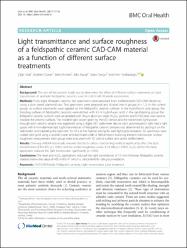| dc.contributor.author | Ural, Çağrı | |
| dc.contributor.author | Duran, İbrahim | |
| dc.contributor.author | Evmek, Betül | |
| dc.contributor.author | Kavut, İdris | |
| dc.contributor.author | Cengiz, Seda | |
| dc.contributor.author | Yüzbaşıoğlu, Emir | |
| dc.date.accessioned | 10.07.201910:49:13 | |
| dc.date.accessioned | 2019-07-10T19:36:22Z | |
| dc.date.available | 10.07.201910:49:14 | |
| dc.date.available | 2019-07-10T19:36:22Z | |
| dc.date.issued | 2016 | en_US |
| dc.identifier.citation | Ural, Ç., Duran, İ., Evmek, B., Kavut, İ., Cengiz, S. ve Yüzbaşıoğlu, E. (2016). Light transmittance and surface roughness of a feldspathic ceramic CAD-CAM material as a function of different surface treatments. BMC Oral Health, 17. https://dx.doi.org/10.1186/s12903-016-0245-5 | en_US |
| dc.identifier.issn | 1472-6831 | |
| dc.identifier.uri | https://hdl.handle.net/20.500.12511/1142 | |
| dc.identifier.uri | https://dx.doi.org/10.1186/s12903-016-0245-5 | |
| dc.description.abstract | Background: The aim of the present study was to determine the effect of different surface treatments on light transmission of aesthetic feldspathic ceramics used in CAD-CAM chairside restorations. Methods: Forty eight feldspatic ceramic test specimens were prepared from prefabricated CAD-CAM blocks by using a slow speed diamond saw. Test specimens were prepared and divided into 4 groups (n = 12). In the control group, no surface treatments were applied on the feldspathic ceramic surfaces. In the hydrofluoric acid group, the bonding surfaces of feldspathic ceramics were etched with 9.5 % hydrofluoric acid. In the sandblasting group the feldspathic ceramic surfaces were air-abraded with 30-µm alumium oxide (Al2O3) particles and Er:YAG laser was used to irradiate the ceramic surfaces. The incident light power given by the LED device and the transmitted light power through each ceramic sample was registered using a digital LED radiometer device. Each polymerization light had a light guide with 8-mm-diameter tips. Light transmission of feldspathic ceramic samples was determined by placing it on the radiometer and irradiating the specimen for 10 s at the highest setting for each light polymerization. All specimens were coated with gold using a sputter coater and examined under a field emission scanning electron microscope. Surface roughness measurement each group were evaluated with 3D optical surface and tactile profilometers. Results: One-way ANOVA test results revealed that both surface conditioning method significantly affect the light transmittance (F:412.437; p < 0.001) and the surface roughness values (F:16.386; p < 0.001). Al2O3 and Er-YAG laser application reduced the light transmission significantly (p < 0.05). Conclusions: The laser and Al2O3 applications reduced the light transmission of 1.5 mm thickness feldspathic ceramic material below the value of 400 mW/cm2 which is critical limit for safe polymerization. | en_US |
| dc.language.iso | eng | en_US |
| dc.publisher | BioMed Central Ltd. | en_US |
| dc.rights | info:eu-repo/semantics/openAccess | en_US |
| dc.rights | Attribution 4.0 International | * |
| dc.rights.uri | https://creativecommons.org/licenses/by/4.0/ | * |
| dc.subject | CAD-CAM Blocks | en_US |
| dc.subject | Feldspathic Ceramic | en_US |
| dc.subject | Laser Treatment | en_US |
| dc.subject | Light-Transmission | en_US |
| dc.title | Light transmittance and surface roughness of a feldspathic ceramic CAD-CAM material as a function of different surface treatments | en_US |
| dc.type | article | en_US |
| dc.relation.ispartof | BMC Oral Health | en_US |
| dc.department | İstanbul Medipol Üniversitesi, Diş Hekimliği Fakültesi, Protetik Diş Tedavisi Ana Bilim Dalı | en_US |
| dc.department | İstanbul Medipol Üniversitesi, Rektörlük, Rejeneratif ve Restoratif Tıp Araştırmaları Merkezi (REMER) | en_US |
| dc.authorid | 0000-0001-5348-6954 | en_US |
| dc.identifier.volume | 17 | en_US |
| dc.relation.publicationcategory | Makale - Uluslararası Hakemli Dergi - Kurum Öğretim Elemanı | en_US |
| dc.identifier.doi | 10.1186/s12903-016-0245-5 | en_US |
| dc.identifier.wosquality | Q2 | en_US |
| dc.identifier.scopusquality | Q1 | en_US |



















